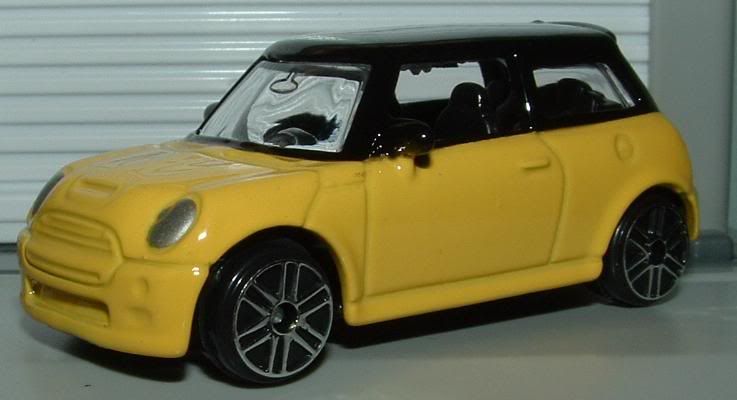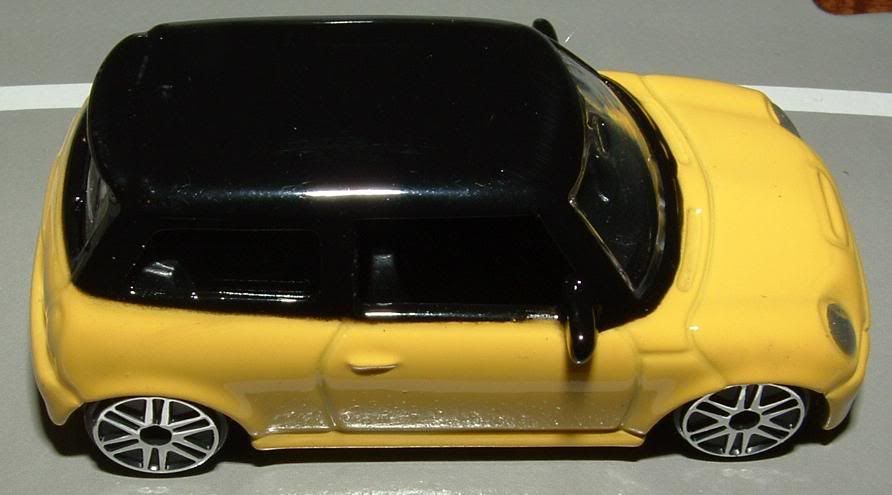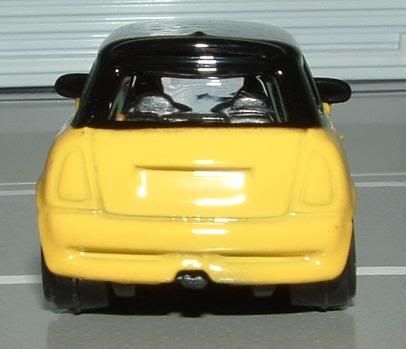
A blog focusing on 1/64 diecast from such popular brands as Hot Wheels, Matchbox, Johnny Lightning, M2 Machines, GreenLight, Tomica, Yat Ming, Majorette, MotorMax, Siku, Corgi, Guisval, Playart, Ertl, Zylmex, Racing Champions, & many more. Swifty's Garage features a daily Car Of The Day and news updates from your favorite brands!
Friday, May 20, 2011
Car Of The Day: May 20, 2011
Today's car of the day is Yat Ming's 2001 Mini Cooper.
Mini (styled as MINI) is a British automotive marque owned by BMW which specialises in small cars.
Mini originated as a specific vehicle, a small car originally known as the Morris Mini-Minor and the Austin Seven, launched by the British Motor Corporation in 1959, and developed into a brand encompassing a range of small cars, including the Clubman, Traveller and Moke. The original two-door Mini continued in production until 2000. Development of a successor began in 1995 and the new generation car was launched in 2001. The Mini range has since expanded from the core two-door Hardtop/Hatch to include the Clubman (estate), Convertible and Countryman (crossover).
The Mini brand originally belonged to British Motor Corporation, which in 1966 became part of British Motor Holdings. British Motor Holdings merged with Leyland Motors in 1968 to form British Leyland. In the 1980s British Leyland was broken-up and in 1988 Rover Group, including Mini, was acquired by British Aerospace. In 1994 Rover Group was acquired by BMW. In 2000 Rover Group was broken-up by BMW, with BMW retaining the Mini brand.
The Mini Hatch/Hardtop, Clubman and Convertible are assembled at Plant Oxford in Cowley, United Kingdom, and the Countryman is assembled by Magna Steyr in Austria.
For more information and pictures of the real car please visit: Mini Cooper
Yat Ming's take on the new MINI is a fairly nice effort. With as many new MINIs as there are in scale, this one is right in the middle of the pack.
The Mini Hatch (US: Hardtop) was designed by Frank Stephenson, and drew inspiration from the original Mini. The name of the new car's brand, MINI, was all-capitalised to distinguish it from its predecessor. Development of the car was conducted between 1995 and 2001 by Rover Group in Gaydon, United Kingdom and BMW AG in Munich, Germany. During this development phase, there was continual contention between the two design groups, especially concerning the positioning of the car; Rover wanted a straight economy car, whilst BMW supported a small, sporting car. Ultimately, BMW prevailed, and in 1999, they assumed control over the entire project following the departure of BMW's CEO, Bernd Pischetsrieder. When BMW divested itself of Rover in 2000, BMW elected to retain the Mini project, and to move the planned production site of the car from Rover's Longbridge plant, to BMW's Oxford plant in Cowley, Oxford, United Kingdom. The team of designers working on the 2001 Mini had finished the full-sized clay mock-up of the Mini in plenty of time for a presentation to the board of directors. However, the chief designer, Frank Stephenson, realised that the model did not have an exhaust pipe. His short-term solution was to pick up an empty beer can, punch a hole in it, strip off the paint and push it into the clay at the back of the car, which took just a few minutes. The overall design for the mock-up was so good that the board members told him not to change a thing, resulting in the distinctive exhaust tip seen in production cars.
The vehicles produced during the 2001 to 2006 model years included four hatchback models (UK and some international markets: Hatch, US: Hardtop, other markets just plain Mini): the standard "Mini One", the diesel-engined "Mini One/D", the sportier "Mini Cooper" and the supercharged "Mini Cooper S"; in 2005, a convertible roof option was added to the Mk I line-up. In November 2006, BMW released a facelift version of the Mini Hardtop as a 2007 model-year vehicle.
The first new generation Mini was introduced in 2001. In many European markets, the Mini One was powered by a 1.4 litre I4 version of the Tritec engine but all other petrol powered Minis used the 1.6 litre I4 version. Since 2005, a soft-top convertible option has been available across the entire range.
There are numerous styling and badging differences between the models, perhaps the most obvious being that the Cooper S has a distinctive scoop cut into the bonnet. The Cooper S also has twin exhausts which exit under the centre of the rear valance. The (non-S) Cooper has more chrome parts than the Mini One and has a single exhaust. The Mini One D has no visible exhaust pipes at all.
In some markets, such as Australia and the U.S., only the Mini Cooper and Cooper S are offered because the Mini One's engine was considered inadequate to deliver sufficient power to run an air conditioner — a necessary feature in those markets. Almost fifty percent of all Minis sold in Australia and about seventy percent of those sold in the U.S. are the more-powerful Cooper S model. Other models of note, sold in varying markets around the world, are the Mini Seven, Mini Park Lane, Mini Check Mate, and Mini Monte Carlo.
The names Cooper and Cooper S echo the names used for the sportier version of the classic Mini, which in turn come from the involvement of John Cooper and the Cooper Car Company. The Cooper heritage is further emphasised with the John Cooper Works (JCW) range of tuning options that are available with the Mini. John Cooper also created a one-off racing model of the Mini Cooper S named the Mini Cooper S Works. This car features many extras which help to improve performance, such as a racing exhaust and air filter as well as uprated suspension. The car also has one-of-a-kind 17-inch (430 mm) racing wheels.
Subscribe to:
Post Comments (Atom)






No comments:
Post a Comment